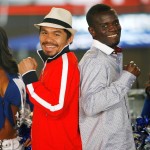Pacquiao-Clottey is all about location, location, location

ARLINGTON, Tex. – It’s all about the building. Cowboys Stadium is the main event. It sits there, below a flight path to a Dallas-Fort Worth runway, rising toward the Texas sky like a giant tent. It’s the big top, a technical marvel that sometimes sounds as if it could be a ride at Disney World.
Next stop:
Manny Pacquiao-versus-Joshua Clottey.
How a Filipino, Pacquiao and an African, Clottey, wound up in the featured event at a state-of-the-art home for America’s Team is either baffling, or just another American import, or a terrific story about diversity. Take your pick. But the fight Saturday night in a ring on the 50-yard-line is unmistakably about location, location, location for a lost sport always trying to find its way back into the mainstream.
For one night at least, Cowboys Stadium looms as a symbol of boxing’s aspirations. Promoter Bob Arum, who has seen just about everything, hasn’t witnessed anything quite like it in the many years since Muhammad Ali’s victory over Cleveland Williams in 1966 at Houston’s space-age Astrodome.
“Since the Astrodome, I have never been in a situation when the venue plays as big a role as the fighters,’’ Arum said.
If Pacquiao wins as predicted, the stadium could become the star.
“Whatever works,’’ Arum said.
What’s at work in the Dallas Metroplex is a potential shift in how boxing markets itself. Over at least the last decade, it has become a casino sport. That means Las Vegas and high-rollers in ringside seats. The rest of the crowd is in the anonymous pay-per-view audience, unheard and known only by a number.
In Dallas, there’s not much talk about the pay-per-view numbers for Pacquiao-Clottey. The guess is between 750,000 and 1,000,000 for the HBO telecast. Good, but not great and probably a long way from the pay-per-view audience expected for the Floyd Mayweather-Shane Mosley showdown on May 1 at Las Vegas’ MGM Grand.
But who’s counting. Only one thing matters here: In moving a bout
with the sport’s biggest international star in Pacquiao from Vegas to an untapped boxing market, it looks as if Arum is reaching out to a new audience with some old-fashioned salesmanship. He’s beginning to go door-to-door, or at least town-to-town.
“Bringing fights to the people,’’ said Arum, who in Pacquiao has a candidate for the Filipino Congress in a campaign that started with a party called the People’s Champ Movement.
The idea is as old as any entertainer hitting the road. If a live crowd likes what it hears or sees, there’s a good chance many in the audience will buy a CD or T-shirt or poster. With a big Mexican and Mexican-American population, Dallas is a good place to find some new pay-per-view customers. After Dallas, Arum moves on to Miguel Cotto-Yuri Foreman at the new Yankee Stadium in New York where he hopes to re-awaken some of history’s legends, including Joe Louis’ rematch victory over Max Schmeling at old Yankee Stadium in a 1938 bout that has become part of the American fabric. Then, the itinerary could include a stop in south Florida at Land Shark Stadium, the Miami Dolphins home.
“You get stale, doing the same thing over and over, going back to casinos to put on these big events,’’ Arum said.
Stale would have been just fine if the showdown had been Pacquiao-Mayweather at the MGM Grand. In fact, a poll probably would have shown a public overwhelmingly in favor of stale. But the Pacquiao-Mayweather possibility fell apart over Mayweather’s demands for Olympic-style blood-testing. Arum traded in stale for intriguing. Will it work? Maybe not.
If Pacquiao is somehow upset by, say, a Clottey head butt and suffers his first loss since a head butt bloodied him in 2005 against Erik Morales, Arum might get nostalgic about stale old days. If Pacquiao prevails, however, there is an opportunity for boxing to re-invent itself all over again.
In Cowboys owner Jerry Jones, Arum appears to have found a kindred spirit. Jones knows that atmosphere is a key to the entertainment art form. If the customers have a good time, they will either be back in line for a ticket or buy the next pay-per-view. It’s no secret that the best advertising is word of mouth. Jones says that only seven percent of NFL fans have ever seen a game in an NFL stadium. But the rest of the country has heard from that seven percent. They have tuned in and turned the NFL into the modern American pastime.
Jones, who says he boxed as an amateur as a 10-year-old at the Boys Club in Little Rock, Ark., is a longtime fan. He remembers days when Roberto Duran and Sugar Ray Leonard fought in Montreal and then in New Orleans. He traveled to Las Vegas to watch Leonard and Marvin Hagler and Thomas Hearns.
“I’ve always thought boxing needs more exposure,’’ Jones said.
In Las Vegas, Jones entry into the sport must looks like a threat, a hostile takeover. Jones bid $25 million, which would have been a record site fee, for Mayweather-Pacquiao. But that possibility was headed to Vegas’ MGM Grand even before talks unraveled
“I wanted that fight, between those two guys, worse than my next breath,’’ Jones said.
Up and down the Vegas Strip, casino executives are holding their breath at what he might try next, especially if Pacquiao-Clottey is a success.
“But I think this is good and not a negative for Las Vegas to have a great fight in front of thousands of people,’’ Jones said in what might prove to be a new look at Sin City’s best-known marketing campaign.
What stays in Vegas isn’t always good for Vegas.
Or boxing.
Photo by Chris Farina / Top Rank